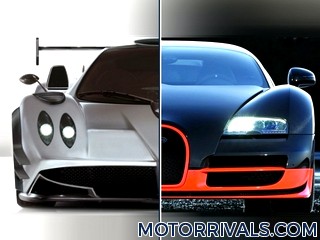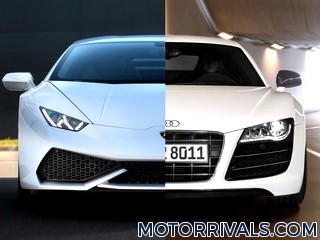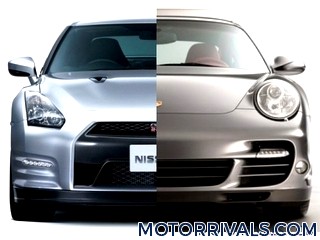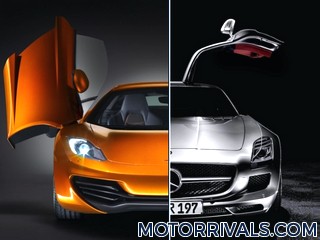2016 Porsche 918 Spyder vs 2016 Ferrari LaFerrari
Porsche Press Release Highlights
The Porsche 918 Spyder marks the start of a new chapter in the future of
the hybrid drive. It embodies the essence of the Porsche idea, combining
pedigree motor racing technology with excellent everyday suitability,
and maximum performance with minimum consumption. And the technology
pioneers are not the only ones who are excited by this flagship project,
as the 918 Spyder demonstrates the potential of the hybrid drive to a
degree never seen before, achieving a parallel improvement in both fuel
efficiency and performance without compromising on either. This is the
idea that has made the Porsche 911 the most successful sports car in the
world for the past 50 years. In short, the 918 Spyder contains the
genetic blueprint for the Porsche sports car of the future.
The core message surrounding the 918 Spyder is that the Porsche hybrid drive offers uncompromising dynamic performance. The unique all-wheel drive concept with a combined combustion engine and electric motor drive system on the rear axle and a second electric motor on the front axle make this possible. The additional, individually controllable front-wheel drive enables new driving strategies to be used for extremely high yet safe speeds through bends in particular. What's more, the advanced "boost" strategy manages the energy of the electric drive so intelligently that the unrestricted total power of the 918 Spyder can be accessed simply by fully depressing the accelerator pedal for every burst of speed at maximum acceleration. In short, the Porsche 918 Spyder allows even drivers without motorsport training to experience the potential of advanced longitudinal and lateral dynamics.
The 918 Spyder continues a long tradition of super sports cars at Porsche. Many of these vehicles have set technological benchmarks and have become the ultimate sports cars of their decades: the Carrera GTS, the first Porsche Turbo, the 959, the 911 GT1 and the Carrera GT. More so than any of its predecessors, the 918 Spyder is providing the key momentum for developing technologies for future vehicle concepts. The Porsche 918 Spyder features all the components that reflect the Porsche DNA in a format that is more powerful than ever before.
• Engine speeds of up to 9150 rpm
• Power output per liter of approx. 132 bhp/liter - 26 bhp/liter more than that of the Carrera GT, making this the highest specific power of any naturally aspirated Porsche engine.
• Two electric motors delivering an additional 279 hp
• Total system delivers 887 hp (661 kW) and 1,280 Nm (940 lb-ft) of torque
• Hybrid module comprises a 115-kW electric motor - can be powered at the rear axle either individually by the combustion engine or the electric motor, or via both drives together.
• Seven-speed Porsche Doppelkupplung (PDK) transmission
• Independent all-wheel drive: Front axle with electric motor - 95 kW of power at the front axle
• Lithium-ion battery with plug-in charging system - liquid-cooled
• Five operating modes
• E-Power: 16 to 32 kilometers on purely electric power. Accelerates from 0 to 100 km/h in under seven seconds and can reach speeds of up to 150 km/h.
• Hybrid: electric motors and combustion engine work alternately
• Sport Hybrid: combustion engine operates continuously. The electric motors are activated to support acceleration through the electric boost function
• Race Hybrid: combustion engine is chiefly used under high load, and charges the battery whenever the driver does not require maximum power. The electric motors provide additional support in the form of boosting in this mode too.
• Hot Lap: releases the 918 Spyder's final reserves and can only be activated in "Race Hybrid" mode. Pushes the traction battery to its maximum power output limits for a few fast laps and uses all of the available energy in the battery.
• 0–100 km/h (62 mph) in 2.5 seconds
• 0-200 km/h (120 mph) in 7.2 seconds
• 0-300 km/h (190 mph) in 19.9 seconds
• Top speed of 218 miles per hour (351 km/h)
• Porsche Active Suspension Management (PASM) adaptive shock-absorber system
• Rear-axle steering - electro-mechanical adjustment system at each rear wheel. The rear axle can be steered in the same direction or in the opposite direction to the front wheels.
• Specially tuned Michelin Pilot Sport Cup 2 tires - 265/35 ZR 20 for the front axle and 325/30 ZR 21 for the rear axle
• Weissach package - super lightweight magnesium wheels reduce the unsprung weight, six-point seatbelts for the driver and front passenger, an optional film coating instead of a paint finish, plus additional aerodynamic add-on parts in visible carbon fiber.
• Porsche Active Aerodynamic (PAA) - adjustable aerodynamic elements works in three stages, switching automatically between optimum efficiency and maximum downforce
The core message surrounding the 918 Spyder is that the Porsche hybrid drive offers uncompromising dynamic performance. The unique all-wheel drive concept with a combined combustion engine and electric motor drive system on the rear axle and a second electric motor on the front axle make this possible. The additional, individually controllable front-wheel drive enables new driving strategies to be used for extremely high yet safe speeds through bends in particular. What's more, the advanced "boost" strategy manages the energy of the electric drive so intelligently that the unrestricted total power of the 918 Spyder can be accessed simply by fully depressing the accelerator pedal for every burst of speed at maximum acceleration. In short, the Porsche 918 Spyder allows even drivers without motorsport training to experience the potential of advanced longitudinal and lateral dynamics.
The 918 Spyder continues a long tradition of super sports cars at Porsche. Many of these vehicles have set technological benchmarks and have become the ultimate sports cars of their decades: the Carrera GTS, the first Porsche Turbo, the 959, the 911 GT1 and the Carrera GT. More so than any of its predecessors, the 918 Spyder is providing the key momentum for developing technologies for future vehicle concepts. The Porsche 918 Spyder features all the components that reflect the Porsche DNA in a format that is more powerful than ever before.
Powertrain
• 4.6-litre, eight-cylinder engine: 608 horsepower (453 kW) at 8,500 rpm and 528 Nm (389 lb-ft) of maximum torque• Engine speeds of up to 9150 rpm
• Power output per liter of approx. 132 bhp/liter - 26 bhp/liter more than that of the Carrera GT, making this the highest specific power of any naturally aspirated Porsche engine.
• Two electric motors delivering an additional 279 hp
• Total system delivers 887 hp (661 kW) and 1,280 Nm (940 lb-ft) of torque
• Hybrid module comprises a 115-kW electric motor - can be powered at the rear axle either individually by the combustion engine or the electric motor, or via both drives together.
• Seven-speed Porsche Doppelkupplung (PDK) transmission
• Independent all-wheel drive: Front axle with electric motor - 95 kW of power at the front axle
• Lithium-ion battery with plug-in charging system - liquid-cooled
• Five operating modes
• E-Power: 16 to 32 kilometers on purely electric power. Accelerates from 0 to 100 km/h in under seven seconds and can reach speeds of up to 150 km/h.
• Hybrid: electric motors and combustion engine work alternately
• Sport Hybrid: combustion engine operates continuously. The electric motors are activated to support acceleration through the electric boost function
• Race Hybrid: combustion engine is chiefly used under high load, and charges the battery whenever the driver does not require maximum power. The electric motors provide additional support in the form of boosting in this mode too.
• Hot Lap: releases the 918 Spyder's final reserves and can only be activated in "Race Hybrid" mode. Pushes the traction battery to its maximum power output limits for a few fast laps and uses all of the available energy in the battery.
• 0–100 km/h (62 mph) in 2.5 seconds
• 0-200 km/h (120 mph) in 7.2 seconds
• 0-300 km/h (190 mph) in 19.9 seconds
• Top speed of 218 miles per hour (351 km/h)
Chassis
• Multi-link chassis• Porsche Active Suspension Management (PASM) adaptive shock-absorber system
• Rear-axle steering - electro-mechanical adjustment system at each rear wheel. The rear axle can be steered in the same direction or in the opposite direction to the front wheels.
• Specially tuned Michelin Pilot Sport Cup 2 tires - 265/35 ZR 20 for the front axle and 325/30 ZR 21 for the rear axle
• Weissach package - super lightweight magnesium wheels reduce the unsprung weight, six-point seatbelts for the driver and front passenger, an optional film coating instead of a paint finish, plus additional aerodynamic add-on parts in visible carbon fiber.
• Porsche Active Aerodynamic (PAA) - adjustable aerodynamic elements works in three stages, switching automatically between optimum efficiency and maximum downforce
Ferrari Press Release Highlights
The special limited-series Ferrari LaFerrari, of which just 499 will be
built, represents an opportunity to experiment with all the
technological solutions that will later filter down onto the production
cars. Of particular significance in this context is the introduction of
the hybrid system which, making full use of the Scuderia Ferrari's F1
KERS know-how, has resulted in a solution that exalts Ferrari's
fundamental values - performance and driving thrills. The hybrid
technology used, known as HY-KERS, represents the perfect combination of
maximum performance and lower emissions. The LaFerrari is equipped with
dynamic controls that are integrated for the first time ever on a
Ferrari road car with active aerodynamics and the HY-KERS system.
Thanks to Ferrari's proprietary logic which govern all the systems, the car can achieve absolute levels of performance, aerodynamic efficiency and handling without any form of compromise in any area. A very advanced and uncompromising approach was also taken with the interior design which features an HMI inspired by F1 single-seaters. The LaFerrari's architecture posed the first challenge for the Prancing Horse team at the planning stage of the design. The aim was to achieve ideal weight distribution (59% at the rear) and a compact wheelbase despite the extra bulk of the hybrid system. The result is that all of the masses are situated between the car's two axles and as close as possible to the floor to lower its center of gravity and thereby guarantee dynamic handling and compact dimensions. The layout of the cabin made a significant contribution in this regard. The seat is fixed and tailored to the driver while both the pedal box and steering wheel are adjustable. The driving position is similar to that of a single-seater. The LaFerrari's chassis features no less than four different types of carbon-fiber, all hand-laminated and autoclave-cured in the racing department using the same design and production methods as the Formula 1 car.
Styling The Ferrari design team led by Flavio Manzoni developed the LaFerrari's styling working in close synergy with the engineers to emphasize the exacting link between form and function. The result is an extreme, innovative design which retains close links to the marque's tradition. This is most evident in its side profile: the car has a sharp, downward-sloping nose and a very low bonnet which emphasizes its muscular wheel arches, a clear nod to the gloriously exuberant forms of late-1960s Ferrari sports prototypes. The LaFerrari's body has been given a sculptural treatment heavily influenced by its clearly F1-inspired aerodynamics and a tail section that exudes uncompromising sportiness.
• 6262 cc V12: 800 PS (588 kW, 789 bhp) @ 9,000 rpm and 700 Nm (516 lb-ft) of torque @ 6,750 rpm
• Revs to a maximum of 9,250 rpm
• High 13.5:1 compression ratio and a high specific output equal to 128 CV per liter
• Coupled with a 163 PS (120 kW; 161 bhp) electric motor
• Total output of 963 PS (708 kW; 950 bhp) and 900 Nm (664 lb·ft) of torque
• The hybrid system is composed of two electric motors developed in collaboration with Magneti Marelli - one powering the driven wheels and the second the ancillaries - and a battery pack attached to the floor of the chassis
• The batteries are charged in different ways: under braking (even hard braking with the ABS active) and every time the V12 produces more torque than required, such as in cornering. In the latter instance, rather than the being sent to the wheels, the excess torque is converted to energy and stored in the batteries.
• The electric motor is coupled with the F1 dual-clutch gearbox
• 0-100 km/h (62 mph) in less than 3 seconds
• 0-200 km/h in under 7 seconds
• 0-300 km/h: 15 seconds
• Maximum speed: over 350 km/h
• Lap time at Fiorano of under 1'20" - 5 seconds faster than the Enzo and over 3 seconds faster than the F12berlinetta.
• The fastest road car in Maranello's long history
• CO2 emissions: 330 g/km
• Gearbox: 7-speed DCT
• Brembo braking system - integrated with the hybrid system and incorporates several new features, including new lightweight calipers and carbon-ceramic material (CCM) discs
• Tires: 265/30 R 19 Pirelli P-Zeros on the front and 345/30 R 20s on the rear
• Weight distribution: 41% front, 59% rear
• Front suspension: double wishbones
• Rear suspension: multi-link
• ESC: stability control
• High performance ABS/EBD: Sistema frenata anti bloccaggio prestazionale /electronic brake balance
• EF1-Trac: F1 electronic traction control integrated with the hybrid system
• E-Diff 3: third generation electronic differential
• SCM-E Frs: magnetorheological damping with twin solenoids (Al-Ni tube)
Thanks to Ferrari's proprietary logic which govern all the systems, the car can achieve absolute levels of performance, aerodynamic efficiency and handling without any form of compromise in any area. A very advanced and uncompromising approach was also taken with the interior design which features an HMI inspired by F1 single-seaters. The LaFerrari's architecture posed the first challenge for the Prancing Horse team at the planning stage of the design. The aim was to achieve ideal weight distribution (59% at the rear) and a compact wheelbase despite the extra bulk of the hybrid system. The result is that all of the masses are situated between the car's two axles and as close as possible to the floor to lower its center of gravity and thereby guarantee dynamic handling and compact dimensions. The layout of the cabin made a significant contribution in this regard. The seat is fixed and tailored to the driver while both the pedal box and steering wheel are adjustable. The driving position is similar to that of a single-seater. The LaFerrari's chassis features no less than four different types of carbon-fiber, all hand-laminated and autoclave-cured in the racing department using the same design and production methods as the Formula 1 car.
Styling The Ferrari design team led by Flavio Manzoni developed the LaFerrari's styling working in close synergy with the engineers to emphasize the exacting link between form and function. The result is an extreme, innovative design which retains close links to the marque's tradition. This is most evident in its side profile: the car has a sharp, downward-sloping nose and a very low bonnet which emphasizes its muscular wheel arches, a clear nod to the gloriously exuberant forms of late-1960s Ferrari sports prototypes. The LaFerrari's body has been given a sculptural treatment heavily influenced by its clearly F1-inspired aerodynamics and a tail section that exudes uncompromising sportiness.
Powertrain
• First car in Ferrari history to be powered by the HY-KERS system• 6262 cc V12: 800 PS (588 kW, 789 bhp) @ 9,000 rpm and 700 Nm (516 lb-ft) of torque @ 6,750 rpm
• Revs to a maximum of 9,250 rpm
• High 13.5:1 compression ratio and a high specific output equal to 128 CV per liter
• Coupled with a 163 PS (120 kW; 161 bhp) electric motor
• Total output of 963 PS (708 kW; 950 bhp) and 900 Nm (664 lb·ft) of torque
• The hybrid system is composed of two electric motors developed in collaboration with Magneti Marelli - one powering the driven wheels and the second the ancillaries - and a battery pack attached to the floor of the chassis
• The batteries are charged in different ways: under braking (even hard braking with the ABS active) and every time the V12 produces more torque than required, such as in cornering. In the latter instance, rather than the being sent to the wheels, the excess torque is converted to energy and stored in the batteries.
• The electric motor is coupled with the F1 dual-clutch gearbox
• 0-100 km/h (62 mph) in less than 3 seconds
• 0-200 km/h in under 7 seconds
• 0-300 km/h: 15 seconds
• Maximum speed: over 350 km/h
• Lap time at Fiorano of under 1'20" - 5 seconds faster than the Enzo and over 3 seconds faster than the F12berlinetta.
• The fastest road car in Maranello's long history
• CO2 emissions: 330 g/km
• Gearbox: 7-speed DCT
Chassis
• Active aerodynamic devices: front diffusers and guide vane on the underbody and rear diffusers and rear spoiler - deploy automatically on the basis of a number of different performance parameters which are monitored in real time by the car's dynamic vehicle controls• Brembo braking system - integrated with the hybrid system and incorporates several new features, including new lightweight calipers and carbon-ceramic material (CCM) discs
• Tires: 265/30 R 19 Pirelli P-Zeros on the front and 345/30 R 20s on the rear
• Weight distribution: 41% front, 59% rear
• Front suspension: double wishbones
• Rear suspension: multi-link
• ESC: stability control
• High performance ABS/EBD: Sistema frenata anti bloccaggio prestazionale /electronic brake balance
• EF1-Trac: F1 electronic traction control integrated with the hybrid system
• E-Diff 3: third generation electronic differential
• SCM-E Frs: magnetorheological damping with twin solenoids (Al-Ni tube)


















